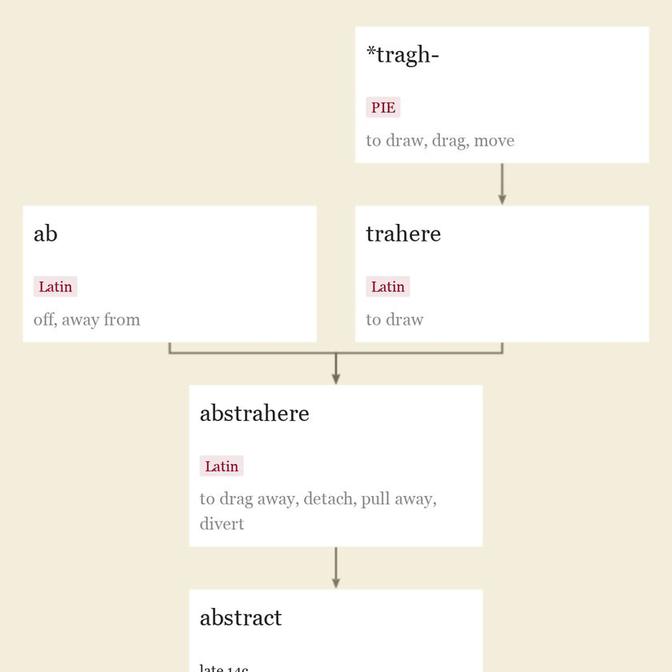abstractly (adv.)
14世纪晚期,“单独地,绝对地,与任何其他事物无关”,来自 abstract(形容词)+ -ly(2)。
abstractly 的相关词汇

14世纪末,最初在语法上使用(指不指称具体事物的名词),源自拉丁语 abstractus “被拖走的”,是 abstrahere 的过去分词,“拖走,分离,拉走,转移”,也具有比喻意义。该单词来源于 ab 的同化形式,“离,远离”(参见 ab-)和 trahere “画”(来自 PIE 词根 *tragh- “画,拖,移动”; 另请参见 tract(n.1))。
哲学中“远离物质对象或实际事务”(相对于 concrete)的含义始于15世纪中期。而“难以理解,深奥”的含义可以追溯到1400年左右。
美术领域中,1914年时开始使用“缺乏具象品质”的表述。自至少从1847年起,它已经成为不伴随歌词的音乐的术语。1952年, Abstract expressionism 作为美国人的自由放任的艺术方式的代表,被杰克逊·波洛克(Jackson Pollock)所体现,但这个术语本身在20世纪20年代就已被用于康定斯基(Kandinsky)等人。
Oswald Herzog, in an article on "Der Abstrakte Expressionismus" (Sturm, heft 50, 1919) gives us a statement which with equal felicity may be applied to the artistic attitude of the Dadaists. "Abstract Expressionism is perfect Expressionism," he writes. "It is pure creation. It casts spiritual processes into a corporeal mould. It does not borrow objects from the real world; it creates its own objects .... The abstract reveals the will of the artist; it becomes expression. ..." [William A. Drake, "The Life and Deeds of Dada," 1922]
奥斯瓦尔德·赫尔佐格在他的一篇关于 "Der Abstrakte Expressionismus"(Sturm,heft 50,1919)的文章中,提出了一份声明,这个声明同样适用于达达艺术家的艺术态度。“抽象表现主义是完美的表现主义,”他写道。“它是纯粹的创造。它将精神过程铸造成有形的模具。它不从现实世界中借用物体,而是创造它自己的物体……抽象的揭示了艺术家的意愿,它变成了表达。“[威廉·德雷克(William A. Drake),《达达的生活和事迹》,1922年]
Then, that art we have called "abstract" for want of any possible descriptive term, with which we have been patient, and, even, appreciative, getting high stimulation by the new Guggenheim "non-objective" Art Museum, is reflected in our examples of "surrealism," "dadaism," and what-not, to assert our acquaintance in every art, fine or other. [Report of the Art Reference Department of Pratt Institute Free Library for year ending June 30, 1937]
然后,那种我们因缺乏任何可能的描述性单词而称之为“抽象艺术”,我们一直在耐心观察并且体会,通过新的古根海姆“非客观”艺术博物馆得到高强度的刺激,这种艺术在我们的“超现实主义”,“达达主义”等例子中得到了反映,以证明我们在每一种艺术,无论是美术还是其他方面,都有了了解。[普拉特学院自由图书馆艺术参考部年度报告,1937年6月30日结束]
常见的副词后缀,由形容词构成副词,表示“以形容词所表示的方式”,中古英语,源自古英语 -lice,源自原始日耳曼语 *-liko-(同源词:古弗里西亚语 -like,古撒克逊语 -liko,荷兰语 -lijk,古高地德语 -licho,德语 -lich,古诺尔斯语 -liga,哥特语 -leiko); 参见 -ly(1)。同源词有 lich,与形容词 like 相同。
Weekley 指出,日耳曼语使用一个基本上意味着“身体”的词来构成副词,而罗曼语使用一个意味着“心灵”的词(如法语 constamment 源自拉丁语 constanti mente)。现代英语形式出现在中古英语晚期,可能受到古诺尔斯语 -liga 的影响。